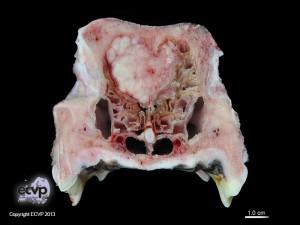
History: Dog, 10 years, male
Diagnoses: Nasal cavity, focally expanding und partially infiltrating neoplastic mass (histologically diagnosed as transitional type meningioma), partially replacing nasal turbinates and nasal septum
Description: Mostly expansive, poorly demarcated, beige, soft neoplastic mass replaced parts of the nasal turbinates and the nasal septum. The neoplastic mass was located mainly within the nasal cavity, but was invasive into the olfactory brain and around the left optical nerve.
Comments: The dog presented clinically with recurrent seizures and ptyalism and was euthanized in a status epilepticus. Bloodwork identified moderate leucocytosis. Necropsy revealed a neoplastic mass that expanded into the olfactory bulb but mainly located within the nasal cavity. Histological examination confirmed the presence of a meningioma of the transitional type with occasional psammoma bodies, as well as a mild inflammatory infiltrate of the meninges and the left optical nerve.
Extracranial meningiomas can either arise from extension of an intracranial meningioma, represent a metastasis of an intracranial meningioma, or arise directly in the nasal cavity, representing primary (para) nasal meningiomas. The latter is favoured in this case due to the presence of large proportions of the neoplastic mass within the nasal cavity. It is hypothesized that (para) nasal meningiomas arise from trapped meningeal arachnoid cells during the development of the skull.
Picture by: Angele Breithaupt, Department of Veterinary Pathology, Freie Universität Berlin, Germany
Author: Stephanie Plog, Department of Veterinary Pathology, Freie Universität Berlin, Germany
